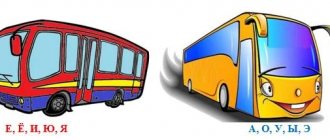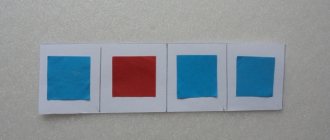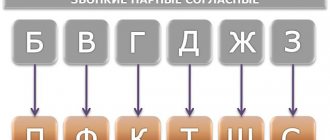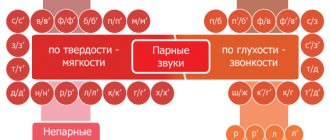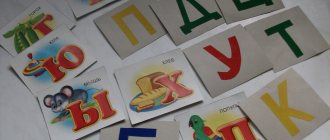We will tell the child about the sounds of vowels and consonants while playing.
Content
We will not start with vowels and consonants. First, let’s draw the child’s attention to the fact that there are many different sounds around us: the rustling of leaves, the chirping of birds, the rumble of cars, the creaking of a door, a telephone ringing, etc. At this stage, I offer the child a game: “Guess what sounds.” Let's prepare an “arsenal” of sounding toys. For example, a tambourine, bell, maracas, wooden sticks and even sheets of paper will do. We let the child touch each item, make noise, rattle, rustle with paper, etc. Then we sit with our backs to each other and begin to guess. We definitely change roles.
Let's talk with the child about the fact that all objects are made of different materials. That’s why they sound differently: a bell made of metal, sticks made of wood...
But what are the words we pronounce made of?
So we got to the most important thing! And words are made up of sounds. But not from any sounds, but from the sounds of human speech. These sounds arise when the speech organs “work”: tongue, lips, teeth, vocal cords.
And the sounds of human speech are DIFFERENT. If you immediately tell a child that there are vowel and consonant sounds, he simply will not understand anything. If explained using the classical definition, then the child will “go out” altogether.
But I really like one definition of vowels and consonants! And children understand it. So, there are sounds - mouth openers (vowels) and there are sounds - mouth openers (consonants). This definition is easily verified and confirmed. To do this, we pronounce a vowel sound. The child repeats after you. Maybe in front of a mirror. And indeed, the mouth opens, and the louder we pronounce the vowel sound, the more the mouth opens. We pronounce a consonant sound. And then we feel that the mouth is closing, and at the same time the tongue is resting somewhere else, bumping into some obstacles.
We draw the child’s attention to the fact that speech sounds can only be heard and pronounced. They cannot be seen or touched. But speech sounds can be identified. For example, multi-colored squares or circles. You will need squares of red, blue and green colors. Red for vowels, blue and green for consonants. Because consonants are divided into hard and soft.
To indicate these sounds, I used baby puree caps, only those that can easily be connected to each other.
In my classes, these caps play different roles: counting material, multi-colored logical chains, a construction set, a mosaic for the development of logic and fine motor skills. Read more about the caps HERE
One important point!!! Don’t rush to turn sounds into letter icons. Train your child in recognizing different speech sounds (vowels, consonants, hard and soft consonants). This is called phonemic hearing training.
Here are examples:
- Say the sound [a], drawn out, the child repeats; pay attention to how the mouth opens; say with increasing volume and the child repeats again, feeling his mouth opening even more - this is a mouth opener sound, mark it with a red square;
- Say the sound [m], briefly at first; the child repeats after you; then make this sound and the child will follow you; the sound stretches out, but the mouth is tightly closed! Here's a mouth opener for you! We denote it with a blue square.
We continue like this with a few more sounds. We do not touch the vowel sounds that indicate the softness of consonants for now.
Train your child to recognize the first sound in a word.
Example:
- Say the word arch, extending the first sound [a] – aaaaarka;
- What is the first sound in this word? What square will you use to mark it? Why? (questions for the child).
- Say the words machine, extending the first sound [m].
- What is the first sound in this word? What square do you use to mark it with? Why? (questions for the child).
Select words in which the first consonant sounds are [m], [s], [r], [x], [w], [r], [v], [z], [l], [n], [zh] . These sounds, although consonants, are drawn out, so they are easy to distinguish intonationally.
If a child does not yet pronounce a sound correctly, then we do not use it.
We train in recognizing various sound combinations and syllables.
- The fusion of two vowels - [ау], [уа], [ао], [уо], [оу]. We pronounce the sound in a chant. We ask the child:
-What is the first sound? What square will we use?
-What is the second sound? What square will we use?
And here my multi-colored caps are very useful, because they are easily connected, attached to each other, so I can clearly show the child how two sounds are fastened together, connected, merged and they must be pronounced without interruption, so that one sound smoothly transitions into another.
- Merging of vowel and consonant – [am], [us], [ov]…
We highlight each sound in the sound combination, denoting it with squares or pictures (read about the pictures below).
- Merging of consonant and vowel sounds (open syllable) – [ma], [so], [well]…
We select each sound in turn and designate it with a diagram.
- The fusion of three sounds - [sma], [snu], [vso]...
We select each sound in turn, make a diagram using squares or pictures.
- A fusion of three sounds, where an open syllable + a consonant (lock). These are short words of three sounds - [moss], [son], [sleep], [nose], [noise].
- A fusion of 4 sounds, where two open syllables are [mother], [fly], [moon], [owl], [Masha], [Sasha]…
And now about the pictures. I have helpers, fascinators and fascinators. These are multi-colored pictures. Girls are red, boys are blue and green.
There are girls and boys separately. They are used to designate those sounds that do not form sound fusions in a word. This picture needs to be cut so that the boy and girl are separate from each other.
There are two red girls - this is a sound fusion of 2 vowels:
There is a pair where the boy is blue + the girl is red. This is an open syllable where the consonant is hard. These children hold hands and are friends. This means that the sound fusion must be pronounced together, so that the consonant smoothly transitions into a vowel.
Here, to begin with, use sound fusions with those consonants that can be pronounced drawn out [m], [s], [r], [x], [r], [v], [z], [l], [n].
There is a couple where the boy is green and the girl is crimson. The girl was deliberately painted crimson so that the vowel sounds, indicating the softness of consonants, would be visually different from other vowels, indicating the hardness of the consonants.
With the help of these colorful children you can create a diagram of any word.
After such exercises and games for the development of phonemic awareness, I move on to getting acquainted with letters.
And more about this HERE
nachalo4ka.ru
Author's didactic manual “Magic Castles of Sounds”
Didactic manual “Magic castles of sounds”
Compiled by: teacher-speech therapist Safonova I.A.
Explanatory note.
Teaching literacy to preschool children is one of the areas of work of a speech therapist teacher. Literacy learning occurs gradually, in a playful way
I would like to tell you about my teaching aid “Magic Castles of Sounds”.
Intended for children of senior preschool age. Can be used both individually and in frontal classes.
To make the manual you needed colored cardboard, markers, scissors, and glue. You can laminate the pictures (I covered them with tape).
Goal: to develop phonemic processes in children
Tasks:
- introduce the concept of vowel sound (consonant sound)
- learn to isolate a sound from a number of sounds, syllables, words.
- learn to determine the position of a sound in a word.
Equipment: red castle, blue-green castle, red, green, blue mugs, fairies, object pictures.
Progress of the game.
First, I introduce children to non-speech sounds (the wind howls, leaves rustle, the noise of household appliances, etc.), then to speech sounds. I start with vowel sounds. I tell the children a fairy tale. In a distant, magical land there is a fairy-tale castle for speech sounds (I show the red castle) and vowel sounds live here. In each lesson we will become familiar with these sounds. Today we will get acquainted with the sound “A” (I show the children the articulation of the sound “A”, I emphasize that when pronouncing the sound “A” nothing interferes with the air, it comes out easily, freely - it is a vowel, we will designate it in red, I show the red circle). Remember, we hear and speak (pronounce) sounds. The vowel sounds are controlled by the vowel fairy (I show the red fairy).
GAME “Catch the sound “A”
The vowel fairy flies off to visit her sisters. The sounds remain unprotected, and our sound “A” wants to “escape” from the castle, we won’t let him do this, as soon as you hear the sound “A” catch it (clap your hands).
a) U-U-I-O-A-E-A-Y-A...
b)mu – we-ma – mi-me-ma...
c) poppy, moh, mir, mayor, cancer, mouth….
The speech therapist identifies vowel sounds with his voice.
GAME "Count"
- Count how many times I say the sound “A” and put the corresponding number of red circles.
- A (one circle); A-A (two mugs)
GAME “Find pictures with the sound “A” and “put them in a castle”
— Guys, help the fairy of vowel sounds choose pictures with the sound “A”
Pictures: flag, poppy, ball, gnome, rice, varnish, whale, lynx, bull, crayfish, etc.
We gradually complicate the pictures, take them not with one vowel, but with two, three, etc. (flour, bag, bus, birch...).
You can come up with other games, for example, “Let's come up with words starting with the sound “A”; “” Let’s determine the place of the sound “A” in the word (beginning, middle, end),” etc.
We play similarly with consonant sounds (locks are blue-green).
Vowels and consonants letters and sounds
Russian alphabet
- A a a
- B b b b b
- In in ve
- G g g
- D d d e
- E e e
- Yo yo yo
- Zhe zhe
- Z ze ze
- And and and
- Thy and short
- K k ka
- L l el
- Mm um
- N n en
- Ooo
- P p pe
- R r er
- S s es
- T t teh
- U u u
- F f ef
- X x ha
- Ts ts tses
- Ch h wh
- Sh sh sha
- Shch shcha
- ъ hard sign
- s s
- b soft sign
- Uh uh
- Yu yu yu
- I I I
| 33 letters | ||
| 10 vowels | 21 consonants | 2 characters |
| a e e and o u y e y i | b c d g g h j j k l m n p r s t f x c h w sch | b b |
| 42 sounds | |||||
| 6 vowels | 36 consonants | ||||
| [a] [i] [o] [y] [s] [e] | Doubles | Unpaired | |||
| Drums | Unstressed | Voiced | Deaf | Voiced | Deaf |
| [b] [b'] [c] [c'] [d] [d'] [e] [d'] [g] [h] [h'] | [p] [p'] [f] [f'] [k] [k'] [t] [t'] [w] [s] [s'] | [th'] [l] [l'] [m] [m'] [n] [n'] [r] [r'] | [x] [x'] [ts] [h'] [w'] | ||
| Doubles | Unpaired | ||||
| Solid | Soft | Solid | Soft | ||
| [b] [c] [d] [e] [h] [j] [l] [m] [n] [p] [r] [s] [t] [f] [x] | [b'] [c'] [g'] [d'] [z'] [k'] [l'] [m'] [n'] [p'] [p'] [s'] [t '] [f'] [x'] | [f] [c] [w] | [th'] [h'] [h'] | ||
How do letters differ from sounds?
Sound is elastic vibrations in any medium. We hear sounds and can create them, among other things, with the help of the speech apparatus (lips, tongue, etc.).
A letter is a symbol of the alphabet. It has a capital (excl., ь and ъ) and lowercase version. Often a letter is a graphic representation of the corresponding speech sound. We see and write letters. To ensure that the writing is not affected by the peculiarities of pronunciation, spelling rules have been developed that determine which letters should be used in the word in question. The exact pronunciation of a word can be found in the phonetic transcription of the word, which is shown in square brackets in dictionaries.
Vowels and sounds
Vowel sounds (“glas” is the Old Slavonic “voice”) are the sounds [a], [i], [o], [u], [s], [e], in the creation of which the vocal cords are involved, and on the way no barrier is erected to the exhaled air. These sounds are sung: [aaaaaaa], [iiiiiiiii]...
Vowel sounds are designated by the letters a, e, e, i, o, u, ы, e, yu, i. The letters e, e, yu, i are called iotized. They denote two sounds, the first of which is [th'], when
- stand first in the phonetic word barely [y'el'e] (3 letters, 4 sounds) also [y'ish'ó] (3 letters, 4 sounds) hedgehog [y'osh] (2 letters, 3 sounds) Julia [ y'ul'a] (3 letters, 4 sounds) apple [y'ablaka] (6 letters, 7 sounds) egg [y'iich'ka] (5 letters, 6 sounds)
- follow after the vowels tarantula [pt'itsy'et] (7 letters, 8 sounds) her [yiy'o] (2 letters, 4 sounds) cabin [kai'uta] (5 letters, 6 sounds) blue [s'in' iya'a] (5 letters, 6 sounds)
- followed by ь and ъ entry [vy'est] (5 letters, 5 sounds) rise [pady'om] (6 letters, 6 sounds) pour [l'y'u] (3 letters, 3 sounds) wings [kryl' y'a] (6 letters, 6 sounds)
The letter and also denotes two sounds, the first of which is [th'], when
- comes after nightingale [salav'y'i] (7 letters, 7 sounds)
In a word, vowel sounds that are emphasized during pronunciation are called stressed, and those that are not emphasized are called unstressed. Stressed sounds are most often both heard and written. To check which letter needs to be placed in a word, you should select a single-root word in which the desired unstressed sound will be stressed.
running [b'igush'iy'] - running [b'ek] mountain [gara] - mountains [mountains]
Two words united by a single accent make up one phonetic word.
to the garden [fsat]
There are as many syllables in a word as there are vowels. The division of a word into syllables may not correspond to the division during hyphenation.
e-e (2 syllables) dot (2 syllables) o-de-va-tsya (4 syllables)
Consonants and sounds
Consonant sounds are sounds that create an obstruction in the path of exhaled air.
Voiced consonants are pronounced with the participation of the voice, and voiceless consonants are pronounced without it. The difference is easy to hear in paired consonants, for example, [p] - [b], when pronounced, the lips and tongue are in the same position.
Soft consonants are pronounced with the participation of the middle part of the tongue and are indicated in transcription by an apostrophe ', which occurs when the consonants
- are always soft [th'], [h'], [sh'] ay [ay'] (2 letters, 2 sounds) ray [ray'] (3 letters, 3 sounds) bream [l'esh'] (3 letters, 3 sounds)
- followed before the letters e, e, i, yu, i, b (excl., always hard [zh], [ts], [sh] and in borrowed words) mel [m'el'] (4 letters, 3 sounds) aunt [t'ot'a] (4 letters, 4 sounds) people [l'ud'i] (4 letters, 4 sounds) life [zhyz'n'] (5 letters, 4 sounds) circus [circus] (4 letters, 4 sounds) neck [sheya] (3 letters, 4 sounds) tempo [temp] (4 letters, 4 sounds)
- come before soft consonants (some cases) pancake [bl'in'ch'ik]
Otherwise, consonant sounds will predominantly be hard.
Sibilant consonants include the sounds [zh], [sh], [h'], [sh']. Speech therapists rule their pronunciation penultimately: the tongue must be strong and flexible to resist exhaled air and be held against the roof of the mouth in the shape of a cup. The last ones in line are always the vibrating [p] and [p'].
Do schoolchildren need phonetics?
Without dividing into vowels, consonants, stressed and unstressed, of course, it is impossible. But the transcription is clearly too much.
Speech therapists are required to know phonetic analysis of words, and it can probably be useful to foreigners.
For students (from 1st grade!) who have not yet mastered the rules of spelling, a fairly in-depth study of phonetics only hinders, confuses and contributes to incorrect memorization of the spelling of words. It is “back” that the child will associate with the pronounced “run”.
Recommended materials:
shpargalkablog.ru
Vowels and consonants of the Russian alphabet
Introducing a child to the Russian alphabet is always an encounter with an unknown but mysterious world, in which there are so many interesting things.
The letters of the Russian alphabet make up a whole family, with 33 inhabitants!
And everyone needs to be remembered in their places. But the study of letters does not end there. We also have to divide them into vowels and consonants, stressed and unstressed, soft and hard, voiceless and voiced . And this is still far from a complete classification. Let's figure out how to correctly divide the letters of the alphabet into groups.
Vowels and consonants sounds and letters
First, let's figure out how many letters the Russian alphabet contains. There are 33 of them in total. They are all divided into two large groups: vowels and consonants.
We cannot attribute only the soft and hard signs to any of the groups: they do not denote sound, but serve to indicate the hardness or softness of the previous sound.
Table with cards of vowels and consonants in the Russian language.
Vowel sounds
Vowel sounds are pronounced easily, in a singsong manner. This is possible due to the fact that during articulation in the mouth there is no obstruction to the air flow.
How many vowels are there in Russian? – 10 letters. Vowel sounds are much smaller: only 6: A, O, U, Y, I, E. This difference is explained by the fact that 4 vowel letters are formed by merging two sounds: E=Y+O; E=Y+E; Yu=Y+U; I=Y+A.
Shocked and unstressed
Vowel sounds can be stressed or unstressed. Stressed vowel sounds in a word are emphasized by the voice. Thanks to stress, we understand the meaning of a word. There are words in which the meaning depends only on the placement of the stress, for example: castle- castle. Unstressed sounds are not pronounced so clearly, so in writing we check unstressed sounds with stress.
How many consonants and sounds are there in the Russian language?
There are only 21 consonants, but there are 37 sounds.
Consonant sounds are formed due to an obstruction that occurs in the mouth during the passage of air flow. The role of an obstruction can be played by teeth, tongue, lips; depending on the nature of the obstruction, consonants are divided into many groups, for example, labial, dental, etc.
Consonants are also divided into hard and soft, voiceless and voiced.
Hard and soft
Hard consonants are pronounced more roughly, while soft ones sound more graceful and are softened by a nearby vowel or in writing using a soft sign. In transcription, soft sounds are indicated by an adjacent apostrophe. For example, in the word HOUSE the letter “d” sounds hard, but in the word GO it sounds soft. Soft and hard consonants are presented in the table.
Voiceless and voiced
Voiceless consonant sounds are pronounced without the participation of the voice, while in the formation of hard sounds the participation of the voice is necessary. Voiced and unvoiced sounds, as a rule, form a pair, for example: B-P, V-F, etc. There are only a few sounds that do not have a voiced-voiced pair: Shch, Ts, Y, R, L, M, N.
The table presented on our website will help you fully consider deaf and voiced, hard and soft consonants, as well as stressed and unstressed vowels. It can be hung in the classroom where children have begun to study the Russian alphabet in more detail. It would also be a good idea to hang the chart in a visible place at home if your child is starting to learn letters.
Tables
Cartoons on the topic
To help your child quickly learn the division of letters into vowels and consonants, you can offer him cartoons on this topic. On our website you will find educational cartoons dedicated to this topic.
Speech therapist. Russian alphabet
This video presents sounds in the Russian language using examples of onomatopoeia. This technique will allow children to practice the clarity of pronunciation of vowels and consonants, and to more clearly feel the difference in their sound. Sounds accompany bright pictures with animals and natural phenomena. You can watch the cartoon here
Learn and sing the Russian alphabet
This video contains a performance of the alphabet to music. The melody is pleasant, easy to remember, and the song itself is accompanied by a display of the letter and form of its writing. This cartoon can be useful for children of any age, as it is aimed not only at remembering the order of letters, but also at practicing diction. You can watch the cartoon here
Voiceless consonants
There is a generally accepted opinion that it is impossible to sing consonants. However, the authors of this cartoon break the usual stereotypes of perception. Of course, this video cannot be called a song in its entirety: rather, we will be dealing with a drawn-out pronunciation of voiceless consonants. This is extremely useful for children's diction, in which defects in the pronunciation of hissing sounds are constantly visible. Play this cartoon for your child more often so that he corrects his diction. You can watch the cartoon here
Voiced consonants
It is much easier to sing voiced consonant sounds, although again we will not be dealing with singing, but with prolonged pronunciation of the sound. The voice is involved in the formation of voiced consonants, so they can be easily chanted. This cartoon invites children to practice this simple task and become more familiar with ringing sounds. You can watch the cartoon here
Learn vowel and consonant sounds, because they form the basis of our alphabet!
steshka.ru
Stressed and unstressed vowels
The vowels in a word are pronounced differently. Only one vowel is always emphasized by the voice and sounds longer than the other vowel sounds, for example in the word:
dog
In the second syllable, the vowel sound indicated by the letter “a” sounds with particular strength and duration.
It is in a strong position and sounds clear and crisp. This vowel sound is stressed.
Let's observe:
- peaceful
- city
- smile
- drawing
In Russian, the strong position for vowels is the stressed position.
The remaining vowel sounds are in a weak position without stress. They sound less clear and are subject to changes during pronunciation. Such sounds in a weak position are called unstressed vowels. To correctly write a word with an unstressed vowel, you will need a test word for it.
Vowels and consonants letters and sounds
What is the difference between vowels and consonants and letters and sounds? What rules do they obey? How are the hardness and softness of sounds and letters indicated? You will receive answers to all these questions in this article.
General information about vowels and consonants
Vowels and consonants represent the basis of the entire Russian language. After all, with the help of their combinations, syllables are formed that form words, expressions, sentences, texts, etc. That is why quite a lot of hours are devoted to this topic in high school.
A person learns what vowels and consonants are in the Russian alphabet already from the first grade. And despite the apparent simplicity of this topic, it is considered one of the most difficult for students.
So, in the Russian language there are ten vowel letters, namely: o, i, a, y, yu, ya, e, e, u, e. During their immediate pronunciation, you can feel how air passes freely through the oral cavity. At the same time, we hear our own voice quite clearly. It should also be noted that vowel sounds can be drawn out (a-a-a-a, uh-uh-uh, i-i-i-i-i, u-u-u-u-u and so on ).
Vowels are the basis of a syllable, that is, they are the ones who organize it. As a rule, Russian words have as many syllables as vowels themselves. Let's give a clear example: u-che-ni-ki - 5 syllables, re-bya-ta - 3 syllables, he - 1 syllable, o-no - 2 syllables and so on. There are even words that consist of only one vowel sound. Usually these are interjections (A!, Oh!, Oooh!) and conjunctions (and, a, etc.).
The spelling of vowels in the roots of words, endings, suffixes and prefixes are very important topics in the Russian Language discipline. After all, without knowing how such letters are written in a particular word, it is quite problematic to compose a literate letter.
Consonants and sounds in Russian
Vowels and consonants letters and sounds vary significantly. And if the first ones can be easily pulled out, then the latter ones are pronounced as briefly as possible (except for hissing ones, since they can be pulled out).
It should be noted that in the Russian alphabet the number of consonant letters is 21, namely: b, v, g, d, zh, z, j, k, l, m, n, p, r, s, t, f, x, ts, h, w, shch. The sounds they denote are usually divided into dull and voiced. What is the difference? The fact is that during the pronunciation of voiced consonants, a person can hear not only the characteristic noise, but also his own voice (b!, z!, r!, etc.). As for the deaf, there is no way to pronounce them loudly or, for example, shout. They only create a kind of noise (sh-sh-sh-sh-sh, s-s-s-s-s, etc.).
Thus, almost all consonant sounds are divided into two different categories:
- voiced - b, c, d, d, g, z, j, l, m, n, r;
- deaf - k, p, s, t, f, x, c, ch, sh.
Softness and hardness of consonants
Not everyone knows, but vowels and consonants can be hard and soft. This is the second most important feature in the Russian language (after voicedness and voicelessness).
A distinctive feature of soft consonants is that during their pronunciation the human tongue takes a special position. As a rule, it moves slightly forward, and its entire middle part rises slightly. As for hard consonants, when pronouncing them, the tongue is pulled back. You can compare the position of your speech organ yourself: [n] - [n'], [t] - [t']. It should also be noted that voiced and soft sounds sound slightly higher than hard ones.
In the Russian language, almost all consonants have pairs based on softness and hardness. However, there are also those who simply do not have them. These include hard ones - [zh], [sh] and [ts] and soft ones - [th'], [h'] and [w'].
Softness and hardness of vowel sounds
Surely few people have heard that the Russian language has soft vowels. Soft consonants are sounds quite familiar to us, which cannot be said about the above-mentioned ones. This is partly due to the fact that in secondary school practically no time is devoted to this topic. After all, it is already clear with the help of which vowels the consonants become soft. However, we still decided to dedicate you to this topic.
So, those letters that are capable of softening the consonants preceding them are called soft. These include the following: i, e, i, e, yu. As for letters such as a, y, y, e, o, they are considered hard because they do not soften the consonants in front. To see this, here are a few examples:
- plastic bag;
- child;
- automobile;
- speech;
- cloth;
- bed;
- computer;
- Peter;
- wood;
- freezing;
- fun;
- small and others.
Indication of the softness of consonant letters during phonetic analysis of a word
Phonetics studies the sounds and letters of the Russian language. Surely, in high school you were asked more than once to do a phonetic analysis of a word. During such an analysis, it is imperative to indicate whether the individually considered consonant is soft or not. If yes, then it must be designated as follows: [n'], [t'], [d'], [v'], [m'], [n']. That is, at the top right next to the consonant letter before the soft vowel, you need to put a kind of dash. The following soft sounds are marked with a similar icon - [th'], [h'] and [w'].
fb.ru
Vowel sounds and syllables
An important feature of a vowel sound is its ability to form a syllable. Alone or together with one or more consonants, a vowel sound makes up a syllable. Let's listen to how the word "garden" is pronounced:
garden
We pronounce it without immediately exhaling the entire stream of air, but releasing it in small portions, in three points. The vowel sound is the main sound in each sound segment of a word, which is called a syllable.
Conclusion
Vowel sounds form syllables in a word.
Let's count the number of vowels and syllables in the word "garden". Three vowel sounds form the same number of syllables.
Rule
There are as many syllables in a word as there are vowel sounds.
We can verify this if we pronounce and divide the words into syllables according to the number of vowels:
- bark
- sa-ra-fan
- dog
- u-chi-tel-ni-tsa
So, vowel sounds can be distinguished from consonants by three main features:
- consist of voice;
- during their formation, air passes freely through the organs of speech;
- form a syllable.
Vowel letters and vowel sounds of the Russian language - diagram, table
In the Russian language there are 10 vowel letters, 6 vowel sounds. Vowel letters: a, i, e, ё, o, u, ы, e, yu, ya. Vowel sounds: [a], [o], [u], [e], [i], [s]. In the school curriculum, vowel sounds are indicated in red on the diagrams. In the elementary grades they explain: vowel letters are called that because they “voice”, are pronounced “vocally,” while consonant letters received this name because they “agree” with the vowels.
Scheme 1. Vowels and vowel sounds of the Russian language.
Stressed and unstressed vowel sounds
Vowel sounds are:
- percussive: juice [o] - ice ['o], forest ['e] - mayor [e], drill [u] - hatch ['u],
- unstressed: water [a], pike perch [u], forest [i].
Note. It is correct to say “stressed syllable” and “unstressed syllable”. Instead of “the stress falls on the vowel,” say “the stress falls on the syllable with the vowel.” However, in the literature there are formulations “stressed vowel” and “unstressed vowel”.
Stressed vowels are in a strong position and are pronounced with greater force and intonation. Unstressed vowels are in a weak position, they are pronounced with less force and can be subject to change.
Note. The designation of the letter e in weak position differs in different school programs. Above we showed the sound [i], in other school programs the designation [e] is found, in the institute program - [ei] (e with the sound i).
Scheme 2. Division of vowels into stressed and unstressed.
In the Russian language there are compound words with primary and secondary stress. In them, we highlight the main stress with strong intonation, and the secondary stress with weak intonation. For example, in the word foam blocks, the main stress falls on the syllable with the letter o, the secondary stress on the syllable with the letter e. In phonetic analysis, the vowel with the main stress is stressed, the vowel with the secondary stress is unstressed. For example: tricuspid, three-year-old.
What are vowel sounds?
Our speech consists of words. Each word in turn is made up of sounds. In order for sound to appear, we use various organs: lungs, windpipe, larynx, mouth, tongue, nose and lips. With the help of the speech organs, a person can pronounce sounds that merge into a word.
The sounds in the word are not the same. Some sounds are made by voice, while others consist of noise and voice. When we begin to speak, we exhale air from the lungs, which rushes down the windpipe into the larynx. The larynx contains the vocal cords. If a stream of air passes freely through them and then does not encounter any obstacles on its path, then the result is a vocal sound consisting of a tone. If, when exhaling, the air makes its way through various obstacles, then a characteristic noise is obtained, typical of consonant sounds.
The term “vowel” is related in meaning to the word “voice”.
It is enough to change the position of your lips and you will get different vowel sounds with your voice. We can verify this if we say the following words:
- house
- chair
- ball
- roar
- shooting gallery
- poem
To form the vowel sound [o], it is enough to round the lips, and by stretching them out with a tube, we get the sound [u]. The vowel sound [a] is pronounced with the mouth wide open. The sound [and] requires you to stretch your lips in a smile.
So, in the Russian language there are six vowel sounds. These sounds in writing are indicated by the corresponding letters:
Vowels
oh, a, y, and, s, uh
Vowels differ from consonant sounds in that they can be pronounced for a long time or sung:
- a-a-ah
- aww
- oh-oh-oh
- i-i-il

